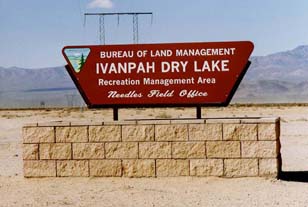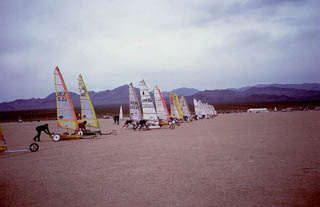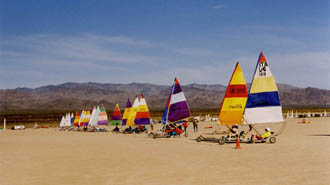 | PACRIM 2000 I can already get a glimpse of some sails from the Interstate Highway 15 which goes from California to Nevada. All that can be seen are bright triangles, because the wheels and hulls are obscured by the angle refraction. Up ahead of me, beyond a desert plain which is sprinkled here and there with low bushes, and raised up on a steep hill, lies the area where we will be staying. If you live in California, this is the nearest place to come to if you are looking to play whatever you want, whether it be slot machines, poker, black jack or roulette. It's just over the border, and right there as you pass into Nevada, where gambling is legal, you come across three enormous hotels with their respective casinos. We have opted for the least expensive of the three: the Whiskey Pete's. As in all deserts of note there are markings, steel signposts that indicate the correct route to follow. Here, where there's practically no chance of getting lost, they serve mainly as an aid to traffic. Nevertheless, in any such environment that is so different from that to which we are accustomed, it makes sense to be careful. I follow the trace of the tyretracks to a sign that asks for a reduction in speed: NO DUST. I've reached the field. I see before me some of the most sophisticated crafts, with their masts outlined and fully taught sails, as well as some of the simplest, with their sail set on, quietly resting, upside down, so that they won't be able to start sailing on their own. I study the architecture, drinking in every last detail. I knock on the door of the race organisers' motorhome, but there's nobody there. |
| No sign of the President of the American Land Sailing Association, Ken Hatch, with whom I have kept in contact over the preceding months. So, I still don't know for sure if there's a craft for me. I explore some more. In between the weathercocks, in the form of pigs, carrots, I can see stars and stripes flags, the anemometres, more landyachts, and, down at the end of the field, the Ironduck, which holds the undisputed speed record. The photos I had downloaded from the official Nalsa site had shown it to be shinier, but for all that the opaque and somewhat shaddy paintwork, and the masking tape that ties the joints together take nothing away from the fascination of this aerodynamic giant which with his wing has managed to reach a speed of 187 kms per hour. |
| The wind is variable. It rises and then dies without warning, leaving you still to while away the time, trailing your fingers on the hard surface of the Ivanpah Dry Lake. Then it blows again, and in those ten minutes or so the whole world turns upside down. I'm worried, not so much about what I'm doing or about how I'm controlling the Manta, as about what is going on around me. How are you supposed to stay calm, to have a precise reference, how are you supposed to know in how may seconds a six or seven metre wide beast of a class II going at 100kms per hour might head your way? At the beginning I keep out of the way so as not to cause any problems. Then I start to understand the game, how much space you need and how much the big guys require in order to manouvre. The most treacherous turn out to be the 5.0's. - more or less the same size as the Manta, yet they reach much greater speeds and, more to the point, they are all over the place. Every time you turn your head to see if you can swerve and there's one right there, with its pilot almost lost inside a synthetic shell, and with those so-called crazy wheels inevitably tilted at an absurd angle. |  |
 | Monday, 9am. The briefing. A welcome and details of the weather forecast for the day. Then on to the rules of the regatta. Here's the thing, though. As soon as the briefing ends, a myriad of little groups are formed, wherein race strategies are explained in a whole manner of ways. There are fingers drawing in the air and twigs busily tracing on the desert sand: starting line, buoys, the near one by means of a bauble called windflasher, a little mirror that rotates in the wind and whose reflection indicates, or at least should, the required position, the further one discerned by a weathervane, and the finishing line. The starting grid is drawn from lots, and is in a way a metaphor of one's destiny. Everything is marked out. For the first race, my initial task is to find position No.2., and I will find it marked on a metal sign attached to the rope that represents the starting line. When the wind is frequently changing direction there are two ropes with signs denoting starting positions. If the wind is coming from the south then more rope is used and you must add 30 to the drawn position. It shouldn't really have been difficult to understand what route to take to return to the base point without being run over by other craft which are being propelled by wind blowing from different directions. But you end up thinking about it and when you are not used to certain situations it takes a while to attain an even moderate sense of security. But then the rest will follow. On Monday I don't get a chance to race. The wind rises late and the Mantra Twins are the last on the roster. But Tuesday is a good day for me, the wind conditions being just right for a debut. I'm sitting there, lined up, when Dave arrives at my shoulder and, perhaps because of the tension, I manage to understand an entire sentence from beginning to end without having to ask for it to be repeated. He says, "Do you feel the adrenaline pumping?" Yes. The green flag is lowered and I take my time starting off so as to see what the others are doing. I see that the gusts are raising the wheels of the craft in front of me and wait my turn on the wind corridor while trying to stay on two wheels as long as possible. Can you go faster balanced on two wheels? I don't know, but it sure is more fun that way. And this is really one of those things that make life worth living. Wednesday is the same thing, and it's hard not to really get into this. I start off well, but when the others begin to swerve I keep out of their way and lose ground. Wheels up, a touch of duelling, not bad at all. Thursday, well, the TV had said it. They were right on the mark and the wind came up. Got to be careful today. It's a disaster. |
| I can't seem to concentrate, I'm not in harmony with the Manta, and my manoevres are clumsy. In these conditions, the ragattas come thick and fast. In the first I get lost and end up near some bushes, but then recover and manage to finish. The second one goes even worse. I set out more concentrated, intending to carry out more swerves than before on the way to the first buoy, but my hands lose their grip of the sail and when I try to work it into the block I get the feeling that something isn't right. I'm given a hand by Cha Cha, a guy from Copenhagen who seems to handle everything with a true enviable spirit. Now he is competing with another person on the seat while he holds the sail with one hand and takes photos with the other, a position he has maintained from the very first regatta. He's nothing less than a volcano of positive energy, and a sportsman in the real sense of the word. Anyway, I pull out of the race, given that the last thing I want to do is cause damage. On Friday it is impossible to race. The wind has grown and, significantly, it raises a great deal of dust. There are a few landyachts around the lake, the Ironduck amongst those. Photoelectric cells have been set to record the speed. The Ironduck is at full speed when some white thing comes off: almost a third of its sail has broken. Game over. Only the prize-giving ceremony is left to be enjoyed. We sit at the table with some pilots who come from the Atlantic coast of the United States. They usually sail on ice. It must be different from a desert, isn't it? "Well, I think so, mostly because the ice could break and next thing your in the lake" Does it happen very often? "It happened to me, to him, and to him as well". We are sort of sorry for being the only ones sitting at that table who did not fall into the icy lake. |
| Home page, What is, Mal'ider cav 01/02, Tomorrow, Links |


